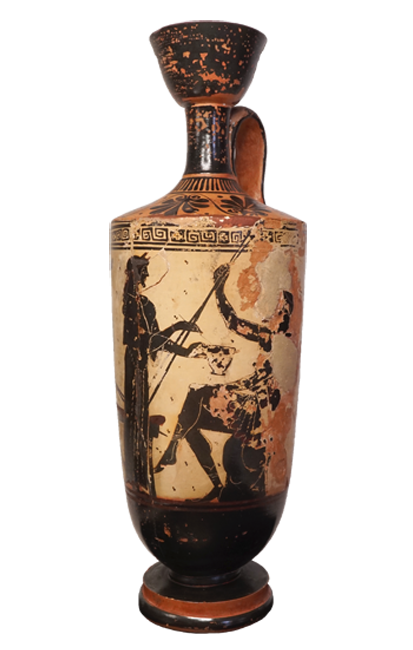Exhibit of the month
Odysseus, who wandered full many ways …
Attic black-figure lekythos
National Archaeological Museum
Vase and Minor Arts Collections, inv. no A1133
Provenance: Eretria
Dimensions: Height: 29 cm, Diam.: 10 cm
Date: 490-480 BC
Display location: Vase Collection, Room 54, Showcase 84
The centre of the lekythos is dominated by a female figure dressed in elegant chiton. Her long loose hair is adorned with a wreath tied around her head with two ribbons. With a wand she stirs the content of a skyphos which she holds in her hand proffering the vessel to a bearded man who is shown sitting on the rocks before her. The man who wears chiton and tall boots, thus mixing a military attire with travel clothing, has laid down his sword next to him, holding two spears in his right hand. The presence of a third figure with the head of a pig and the body of a man, which is depicted moving away from the other two, is the key for the identification of the woman as Circe[1] the witch and the man as much-enduring Odysseus.
The vase illustrates an episode from the nostos (homecoming) of Odysseus who wandered the seas for years, as a ritual that celebrates his return to society from which he was taken away when he disrespected the gods by plundering their temples during the Sack of Troy. According to Book X of the Odyssey, the ship of the king of Ithaca reached Aeaea, the island of the goddess Circe, who on the pretext of hospitality, enticed Odysseus’ companions into entering her palace where she offered them a drink mixed with honey and herbs that affected their memory in order to make them forget their homeland. She then struck them with her magic wand and turned them into pigs. The resourceful Odysseus undertook to rescue his friends. Assisted by the god Hermes who supplied the hero with an antidote called moly, he managed to break the spell and forced Circe to restore his comrades to their human form.
The name of the goddess, which means hawk, is revealing of her true nature. She is a vulturous goddess – witch who encroaches upon the nature of humans transforming them into wild beasts. Besides, magic was often associated with the female gender, both mortal women and nymphs, who used tricks so as to manipulate situations in their favour. Nevertheless, Hermes, as one of the Olympian gods who have authority over the world offers the solution and salvation to the mortal man. Circe cannot but submit to the omnipotence of the gods who regulate the Cosmos and its order, and from witch she becomes Odysseus’ lover and eventually his guide, since in the end she helps him find his way back to Ithaca.
[1] a dread goddess of human speech, own sister to Aeetes of baneful mind; and both are sprung from Helius, who gives light to mortals (Odyssey, x 136-139) English Translation by A.T. Murray, PH.D. in two volumes. Cambridge, MA., Harvard University Press; London, William Heinemann, Ltd. 1919
Bibliography:
Γ. Τζεδάκις, (ed.). Από τη Μήδεια στη Σαπφώ, Κατάλογος Έκθεσης, Αθήνα 1995.
P. Vidal- Naquet, Ο κόσμος του Ομήρου, Αθήνα 2002.
E. Sellers, Three Attic lekythoi from Eretria, JHS 13, (1892-93): 7-9.


